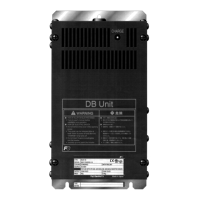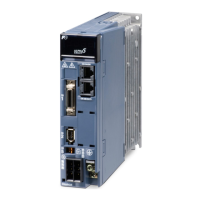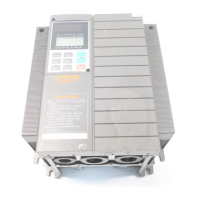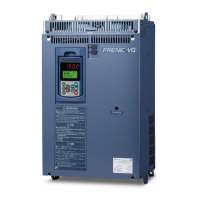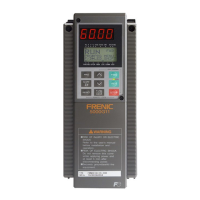2-34
2.3.8 Setting up slide switches and handling control circuit terminal symbol plate
Before changing the switches or touching the control circuit terminal symbol plate, turn OFF the power and
wait more than five minutes for models of 30HP for 208V, 40HP for 460V or below, or ten minutes for models
of 40HP for 208V, 50HP for 460V or above. Make sure that the LED monitor and charging lamp (on models
of 40HP for 208V, 50HP for 460V or above) are turned OFF. Further, make sure, using a multimeter or a
similar instrument, that the DC link bus voltage between the terminals P (+) and N (-) has dropped below the
safe voltage (+25 VDC).
An electric shock may result if this warning is not heeded as there may be some residual electric
charge in the DC bus capacitor even after the power has been turned off.
Setting up the slide switches
Switching the slide switches located on the control PCB allows you to customize the operation mode of the
analog output terminals, digital I/O terminals, and communications ports. The locations of those switches are
shown in Figure 2.29.
To access the slide switches, remove the front and terminal block covers so that you can watch the control PCB.
For models of 40HP for 208V, 50HP for 460V or above, open also the keypad enclosure.
For a screw terminal base, close the control circuit terminal symbol plate since the plate being opened interferes
with switching of some switches.
For details on how to remove the front cover, terminal block cover, and keypad enclosure, refer to Section
2.3.1, "Removing and mounting the terminal block (TB) cover and the front cover" and Chapter 1, Section
1.2, "External View and Terminal Blocks," Figure 1.4.
Table 2.11 lists function of each slide switch.
Table 2.11 Function of Each Slide Switch
Switch Function
SW1 Switches the service mode of the digital input terminals between SINK and SOURCE.
▪ To make the digital input terminal [X1] to [X5], [FWD] or [REV] serve as a current sink, turn
SW1 to the SINK position.
▪ To make them serve as a current source, turn SW1 to the SOURCE position.
Factory default : SINK
SW3 Switches the terminating resistor of RS-485 communications port on the inverter on and off.
▪ To connect a keypad to the inverter, turn SW3 to OFF. (Factory default)
▪ If the inverter is connected to the RS-485 communications network as a terminating device,
turn SW3 to ON.
SW4 Switches the output mode of the analog output terminal [FMA] between voltage and current.
When changing this switch setting, also change the data of function code F29.
SW4 Set data of F29 to:
Voltage output (Factory default) VO 0
Current output IO 1
SW5 Switches property of the analog input terminal [V2] for V2 or PTC.
When changing this switch setting, also change the data of function code H26.
SW5 Set data of H26 to:
Analog frequency command in
voltage
(Factory default)
V2 0
PTC thermistor input PTC 1 or 2

